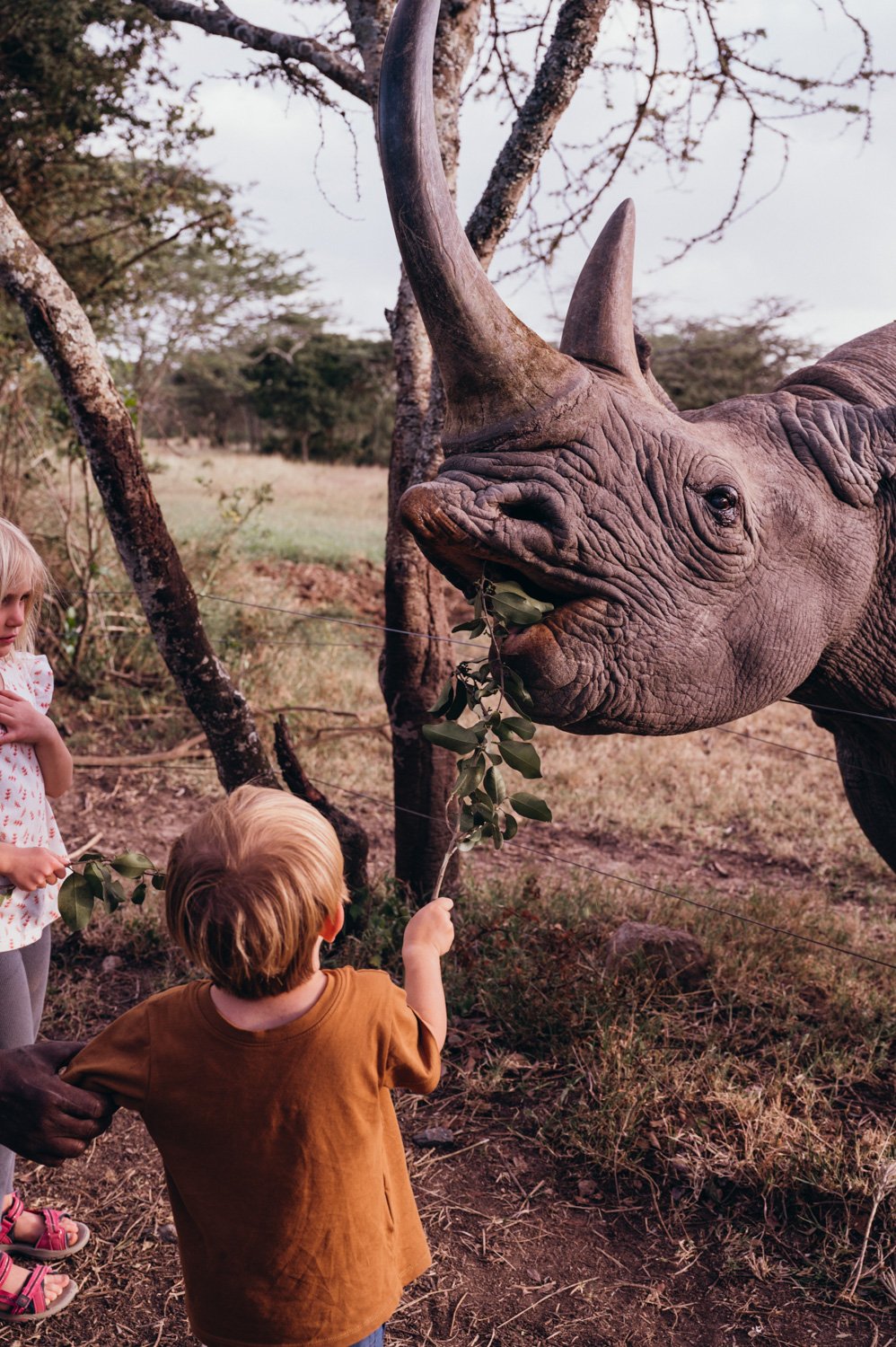The Bridge Between Animals and Us: James Mwenda
Kenyan wildlife advocate and former caretaker of the last male northern white rhino puts care and conservation at the center of his expeditions.
Most animal lovers remember that solemn day in 2018 when it finally happened— Sudan, the last male northern white rhino on earth, had passed away.
The waves of images of Sudan in his final moments went viral, so intimately and profoundly captured by one of the great conservation photographers of our time, Ami Vitale. Lovingly flanked by those who had taken care of him at Kenya’s Ol Pejeta Conservancy, caressing his nuzzle, massaging his tube-shaped ears and softly speaking to him— it was enough to break even the toughest realist. When he passed, we all wept deeply, not just for Sudan, but because when we lost him we lost something of ourselves.
One of his caretakers was James Mwenda. James’s deep connection to the last of a keystone species— an animal that holds together the complex web of relationships in an ecosystem— is as profound as it is devastating. We all knew something was wrong if this animal marked the end an evolutionary journey spanning millions of years (fossil records read that the lineage could be more than 50 million years old). I remember as a high school student writing a report about the decades of war, habitat loss and poaching that had decimated rhino populations, and now here I was, a mom, wondering if these ancient beings would exist only in the books I read to my children.
But the lifelong conservationist in James has given me hope. By translating his experience with human wildlife conflict and as a ranger at Ol Pejeta into a global species ambassadorship, a career as a sought-after speaker, and now with a new expedition company leading safaris with intent, he’s blazing the trail for instilling a sense wildlife stewardship in both.
Ol Pejeta Conservancy
We road-tripped around Kenya in early 2022 and had the honor of visiting the sanctuary James did such important work at. With 90,000 acres of roaming space, Ol Pejeta is the largest black rhino sanctuary in East Africa, and the only place in Kenya to see chimpanzees. It operates as a communal conservancy: through education, healthcare and infrastructure, the people living around its borders are thus incentivized to protect it (65% of Kenya’s wildlife live outside of government-protected areas, so community-led conservancies are a model of sustainable tourism that protects people, wildlife and land).
Alongside seeing Najin and Fatu, Sudan’s daughter and granddaughter (and the last two northern white rhinos on earth), the kids met Baraka, a blind black rhino who had lost his sight years ago in a fight with another rhino. Baraka is the natural ambassador at Ol Pejeta and spends his days visiting with his adoring fans from around the world.
About James Mwenda
A 2018 recipient of the African Ranger of the Year Award, James has become a global ambassador for conservation and the realities of extinction. His passion to become an advocate for wildlife started as a child, witnessing the impact of human-wildlife conflict in his village growing up in the foothills of Mount Kenya. He decided to become an agent of change himself and moved to Ol Pejeta to caretake for Sudan and the last remaining northern black rhinos.
“I realized there was a need of a people who would act as a bridge between animals and people. And that is when the dream was born of being a conservationist.”
James sees tourism as a cornerstone of conservation and a way to educate visitors about Kenya’s crucial role in protecting some of our planet’s most special, and most endangered species. He’s also a globally-known speaker, the subject (and narrator) of the film Kifaru, and his most recent venture: an intentional and eco-friendly safari expedition company, Jemu Expeditions.
The ‘Anti-Checklist’ Safari
Jemu Expeditions’s first priority is not how many of the Big Five you can see or how much ground you cover in a day— it’s to honor and help advocate for Africa’s endangered species. They are decidedly “anti-checklist”— something that the sustainable traveler can really get behind. That means opting for a slower and more intimate safari experience, observing animals for longer stretches of time, being ultimately present with the surrounding landscape. Parents can happily identify with this model: they know traveling with littles requires stopping to observe every stone, stick and creepy crawly thing. Kids are the epitome of slow and present travel— and what better way to experience true Zen than with a predator three times your size having a nap a few meters away?
What Makes Jemu Expeditions Eco-Friendly
The “anti-checklist” and prioritize the slow + present safari experience.
Education about + advocacy for endangered species.
Tailored to educate + inspire kids of all ages.
Partnering with and supporting locally-owned family businesses, socially + environmentally responsible accommodations.
Family Safaris with Jemu Expeditions
A family safari in Kenya with Jemu Expeditions could be going out a few times during the day, doing a night game drive, bird watching, or simply frolicking around, surrounded by wildlife— that’s the essence of it, isn't it? It’s tailored to the age of your children and what they can resonate with. Our kids were five and two when we visited Kenya, and spent hours sitting on top of the truck, pointing at animals, running around the lodges during sunset and watching Vervet monkeys hop from roof to roof (and try to steal your fanny pack!).
James suggests taking your family through naturally Ol Pejeta, Lake Nakuru National Park, Solio Ranch, Nairobi National Park where you can actually see the cityscape from the field, the Giraffe Centre, Samburu Game Reserve with almost a thousand elephants, and the Reteti Elephant Sanctuary: Africa’s first community-owned elephant sanctuary.
We love Jemu’s safari with intent, the opportunity to give kids the sensory knowledge they need to bring conservation into their daily lives, and help preserve these beautiful, fragile species for generations to come. We’re excited to see what your family thinks.
Keep in Touch with James
Watch the film Kifaru (Mountainfilm 2019)
Listen to this fantastic podcast episode, “Is Conservation Tourism Responsible?” on Alpaca My Bags
A beautiful moment between James and Fatu captured by Ami Vitale.
James and Sudan on Google Arts and Culture.










